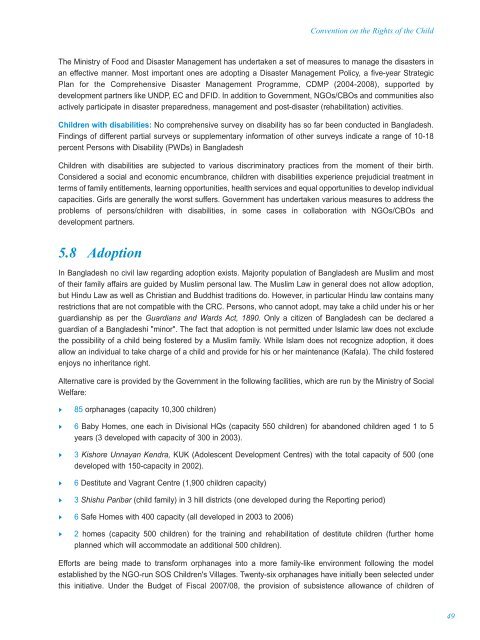Third and Fourth Periodic Report on CRC - Unicef
Third and Fourth Periodic Report on CRC - Unicef
Third and Fourth Periodic Report on CRC - Unicef
You also want an ePaper? Increase the reach of your titles
YUMPU automatically turns print PDFs into web optimized ePapers that Google loves.
C<strong>on</strong>venti<strong>on</strong> <strong>on</strong> the Rights of the Child<br />
The Ministry of Food <str<strong>on</strong>g>and</str<strong>on</strong>g> Disaster Management has undertaken a set of measures to manage the disasters in<br />
an effective manner. Most important <strong>on</strong>es are adopting a Disaster Management Policy, a five-year Strategic<br />
Plan for the Comprehensive Disaster Management Programme, CDMP (2004-2008), supported by<br />
development partners like UNDP, EC <str<strong>on</strong>g>and</str<strong>on</strong>g> DFID. In additi<strong>on</strong> to Government, NGOs/CBOs <str<strong>on</strong>g>and</str<strong>on</strong>g> communities also<br />
actively participate in disaster preparedness, management <str<strong>on</strong>g>and</str<strong>on</strong>g> post-disaster (rehabilitati<strong>on</strong>) activities.<br />
Children with disabilities: No comprehensive survey <strong>on</strong> disability has so far been c<strong>on</strong>ducted in Bangladesh.<br />
Findings of different partial surveys or supplementary informati<strong>on</strong> of other surveys indicate a range of 10-18<br />
percent Pers<strong>on</strong>s with Disability (PWDs) in Bangladesh<br />
Children with disabilities are subjected to various discriminatory practices from the moment of their birth.<br />
C<strong>on</strong>sidered a social <str<strong>on</strong>g>and</str<strong>on</strong>g> ec<strong>on</strong>omic encumbrance, children with disabilities experience prejudicial treatment in<br />
terms of family entitlements, learning opportunities, health services <str<strong>on</strong>g>and</str<strong>on</strong>g> equal opportunities to develop individual<br />
capacities. Girls are generally the worst suffers. Government has undertaken various measures to address the<br />
problems of pers<strong>on</strong>s/children with disabilities, in some cases in collaborati<strong>on</strong> with NGOs/CBOs <str<strong>on</strong>g>and</str<strong>on</strong>g><br />
development partners.<br />
5.8 Adopti<strong>on</strong><br />
In Bangladesh no civil law regarding adopti<strong>on</strong> exists. Majority populati<strong>on</strong> of Bangladesh are Muslim <str<strong>on</strong>g>and</str<strong>on</strong>g> most<br />
of their family affairs are guided by Muslim pers<strong>on</strong>al law. The Muslim Law in general does not allow adopti<strong>on</strong>,<br />
but Hindu Law as well as Christian <str<strong>on</strong>g>and</str<strong>on</strong>g> Buddhist traditi<strong>on</strong>s do. However, in particular Hindu law c<strong>on</strong>tains many<br />
restricti<strong>on</strong>s that are not compatible with the <strong>CRC</strong>. Pers<strong>on</strong>s, who cannot adopt, may take a child under his or her<br />
guardianship as per the Guardians <str<strong>on</strong>g>and</str<strong>on</strong>g> Wards Act, 1890. Only a citizen of Bangladesh can be declared a<br />
guardian of a Bangladeshi "minor". The fact that adopti<strong>on</strong> is not permitted under Islamic law does not exclude<br />
the possibility of a child being fostered by a Muslim family. While Islam does not recognize adopti<strong>on</strong>, it does<br />
allow an individual to take charge of a child <str<strong>on</strong>g>and</str<strong>on</strong>g> provide for his or her maintenance (Kafala). The child fostered<br />
enjoys no inheritance right.<br />
Alternative care is provided by the Government in the following facilities, which are run by the Ministry of Social<br />
Welfare:<br />
85 orphanages (capacity 10,300 children)<br />
6 Baby Homes, <strong>on</strong>e each in Divisi<strong>on</strong>al HQs (capacity 550 children) for ab<str<strong>on</strong>g>and</str<strong>on</strong>g><strong>on</strong>ed children aged 1 to 5<br />
years (3 developed with capacity of 300 in 2003).<br />
3 Kishore Unnayan Kendra, KUK (Adolescent Development Centres) with the total capacity of 500 (<strong>on</strong>e<br />
developed with 150-capacity in 2002).<br />
6 Destitute <str<strong>on</strong>g>and</str<strong>on</strong>g> Vagrant Centre (1,900 children capacity)<br />
3 Shishu Paribar (child family) in 3 hill districts (<strong>on</strong>e developed during the <str<strong>on</strong>g>Report</str<strong>on</strong>g>ing period)<br />
6 Safe Homes with 400 capacity (all developed in 2003 to 2006)<br />
2 homes (capacity 500 children) for the training <str<strong>on</strong>g>and</str<strong>on</strong>g> rehabilitati<strong>on</strong> of destitute children (further home<br />
planned which will accommodate an additi<strong>on</strong>al 500 children).<br />
Efforts are being made to transform orphanages into a more family-like envir<strong>on</strong>ment following the model<br />
established by the NGO-run SOS Children's Villages. Twenty-six orphanages have initially been selected under<br />
this initiative. Under the Budget of Fiscal 2007/08, the provisi<strong>on</strong> of subsistence allowance of children of<br />
49
















